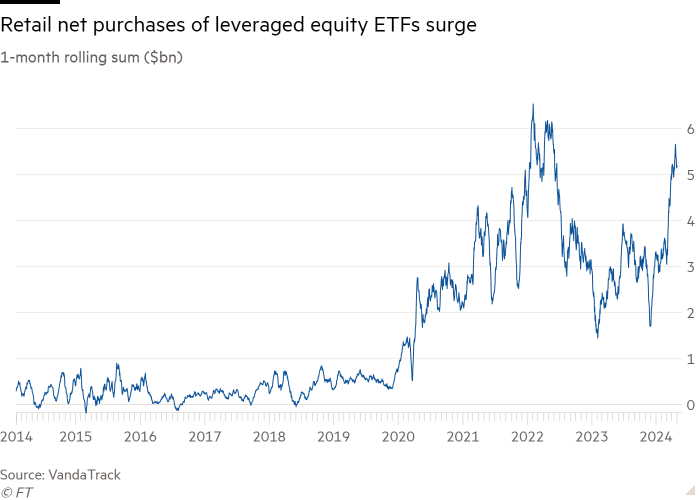Unlock the Editor’s Digest for free
Roula Khalaf, Editor of the FT, selects her favourite stories in this weekly newsletter.
Yield-hungry retail investors piled into highly leveraged US exchange traded funds in April, drawn to volatile markets stoked by uncertainty over the outlook for interest rates.
Investors have pushed around $5.2bn into the top 22 leveraged ETFs, which can magnify potential gains and losses, in the year to the end of April, according to VandaTrack, a data company which monitors retail trading flows.
The inflows marked a reversal from the first quarter as investors pulled money out of passive funds while the benchmark S&P 500 repeatedly hit record highs. But fresh tensions in the Middle East and uncertainty about the path of US interest rates acted as a “catalyst” for investors to snap up leveraged ETFs “to speculate on the market falling or hedge long exposures,” said Ben Slavin, global head of ETFs at BNY Mellon Asset Servicing.
Data from Morningstar Direct, which covers a broader range of leveraged ETFs, indicated that a surge in retail interest in the last two months has also wiped out the outflows of $4.2bn in January and February. Altogether there were inflows of nearly $4.4bn in March and April, it found.
“Market timing is often the Achilles heel of day traders, and this time was no different,” said Bryan Armour, Morningstar’s director of passive strategies research. “Most of the top ETFs by March and April inflows had their worst monthly performance of the year in April.”
Although the inflows represent a sliver of the more than $200bn that has poured into the $8.9tn US ETF market this year, it has reawakened concerns that retail investors will be most exposed to sharp falls. Typically they use derivatives to deliver multiples of the daily performance of the benchmark or index they track.
Investors who use these sorts of instruments to chase potentially large short-term returns are inherently “much more susceptible to equity pullbacks,” said Marco Iachini, senior vice-president of research at Vanda Track.
Following their introduction in 2006, leveraged ETFs have proliferated across US stock markets. Issuers offer double or triple leveraged funds that can track a range of assets, from other ETFs, or specific indices like home construction or banks, bitcoin futures and popular individual securities like Tesla and Nvidia, among dozens of other securities. There are also leveraged inverse ETFs, which allow investors to hedge their exposure to sharp falls. Leveraged single stocks tend to be more volatile than indices.

The US Securities and Exchange Commission last year warned investors that over long periods of time the performance of leveraged and inverse ETFs could differ “significantly” from the product it tracks, especially in unstable markets. They have the potential to create “significant and sudden losses”, it added.
Unlike traditional ETFs, leveraged versions must rebalance at the end of every trading day to deliver their targeted returns. If the price of the underlying asset rises 5 per cent on one day, the value of a corresponding double-leveraged ETF would rise 10 per cent and be required to increase its market exposure before trading starts the next day.
VandaTrack’s data suggests the products are only becoming more popular. In January, a user of Reddit’s popular Wall Street Bets forum said they had “gambled” $50,000 Canadian dollars on a triple-leveraged long ETF tracking a 20-year Treasury bond index. The ETF has since fallen 31 per cent.



